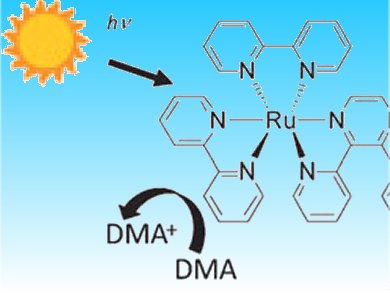A large increase in the efficiency of photocatalytic systems for the production of H2 has been reported by Karen Brewer and co-workers, Virginia Polytechnic Institute and State University, USA. The team use a [{(bpy)2Ru(dpp)}2RhBr2]5+ photocatalyst which couples a RuII light absorber to a RhIII electron collecting site in a single-component, supramolecular system. Supramolecular photocatalysts provide efficient intramolecular electron transfer pathways, eliminating the need for diffusional contact.
The catalyst works at room temperature, in basic pH, and under significant H2 pressure. It produced 4-times more H2 per absorbed photon than its rivals and could generate 20-times more H2 before deactivation. It also demonstrates excellent long-term stability with prolonged use providing 820 mol of H2 per mole of catalyst.

Image: (c) Wiley-VCH (DMA= N,N-dimethylaniline: bpy=2,2’-bipyridine; dpp=2,3-bis(2-pyridyl)-pyrazine)
- High Turnover in a Photocatalytic System for Water Reduction to Produce Hydrogen Using a Ru, Rh,Ru Photoinitiated Electron Collector
Shamindri M. Arachchige, Ryan Shaw, Travis A. White, Vimal Shenoy, Hei-Man Tsui, Karen J. Brewer,
ChemSusChem 2011.
DOI: 10.1002/cssc.201000399



